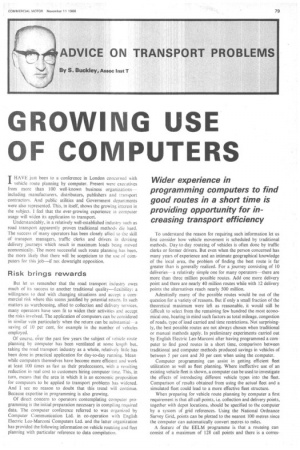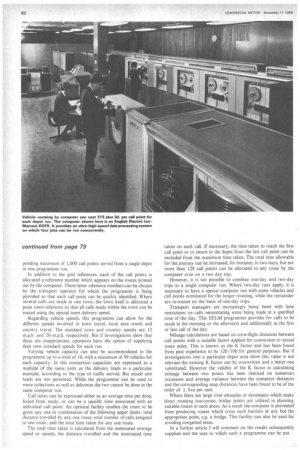GROWING USE OF COMPUTERS
Page 81

Page 82

If you've noticed an error in this article please click here to report it so we can fix it.
Wider experience in programming computers to find good routes in a short time is providing opportunity for increasing transport efficiency
T HAVE just been to a conference in London concerned with
vehicle route planning by computer. Present were executives from more than 100 well-known business organizations including manufacturers, distributors, publishers and transport contractors. And public utilities and Government departments were also represented. This, in itself, shows the growing interest in the subject. I feel that the ever-growing experience in computer usage will widen its application to transport.
Understandably, in a relatively well-established industry such as road transport apparently proven traditional methods die hard. The success of many operators has been closely allied to the skill of transport managers, traffic clerks and drivers in devising delivery journeys which result iri maximum loads being moved economically. The more successful such route planning has been, the more likely that there will be scepticism to the use of computers for this job—if not downright opposition.
Risk brings rewards
But let us remember that the road transport industry owes much of its success to another traditional quality—flexibility: a willingness to deal with changing situations and accept a commercial risk where this seems justified by potential return. In such matters as warehousing, allied to collection and delivery services, many operators have seen fit to widen their activities and accept the risks involved. The application of computers can be considered in similar vein particularly when the return can be substantial--a saving of 10 per cent, for example in the number of vehicles employed.
Of course, over the past few years the subject of vehicle route planning by computer has been ventilated at some length but, taking the road transport industry as a whole, relatively little has been done in practical application for day-to-day running. Meanwhile computers themselves have become more efficient and work at least 100 times as fast as their predecessors, with a resulting reduction in real cost to customers hiring computer time. This, in turn, means that the area in which it is an economic proposition for computers to be applied to transport problems has widened. And I sec no reason to doubt that this trend will continue. Because expertise in programming is also growing.
Of direct concern to operators contemplating computer programming is the initial preparation necessary in compiling required data, The computer conference referred to was organized by Computer Communication Ltd. in co-operation with English Electric Leo-Marconi Computers Ltd. and the latter organization has provided the following information on vehicle routcing and fleet planning with particular reference to data compilation. To understand the reason for requiring such information let us first consider how vehicle movement is scheduled by traditional methods. Day-to-day routeing of vehicles is often done by traffic clerks or former drivers. But even when the person concerned has many years of experience and an intimate geographical knowledge of the local area, the problem of finding the best route is far greater than is generally realized. For a journey consisting of 10 deliveries---a relatively simple one for many operators--there are more than three million possible routes. Add one more delivery point and there are nearly 40 million routes while with 12 delivery points the alternatives reach nearly 500 million.
Admittedly many of the possible routes would be out of the question for a variety of reasons. But if only a small fraction of the theoretical maximum were left as reasonable, it would still be difficult to select from the remaining few hundred the most economical one, bearing in mind such factors as total mileage, congestion of roads, type of load carried and time restrictions. Not surprisingly, the best possible routes are not always chosen when traditional or manual methods apply. In preliminary experiments carried out by English Electric Leo-Marconi after having programmed a cornputer to find good routes in a short time, comparison between traditional and computer methods produced savings in vehicles of between 5 per cent and 30 per cent when using the computer.
Computer programming can assist in getting efficient fleet utilization as well as fleet planning. Where ineffective use of an existing vehicle fleet is shown, a computer can be used to investigate the effects of introducing different vehicle types into the fleet. Comparison of results obtained from using the actual fleet and a simulated fleet could lead to a more effective fleet structure.
When preparing for vehicle route planning by computer a first requirement is that all call points, i.e. collection and delivery points, together with depot locations, should be specified to the computer by a system of grid references. Using the National Ordnance Survey Grid, points can be plotted to the nearest 100 metres since the computer can automatically convert metres to miles.
A , feature of the EELM programme is that a routeing can consist of a maximum of 128 call points and there is a corres ponding maximum of 1,000 call points served from a single depot in one programme run.
In addition to the grid references, each of the call points is allocated a reference number which appears on the routes printed out by the computer. These latter reference numbers can be chosen by the transport operator for whom the programme is being provided so that each call point can be quickly identified. Where several calls are made in one town, the town itself is allocated a point town reference so that all calls made within the town can be routed using the special town delivery speed.
Regarding vehicle speeds, this programme can allow for the different speeds involved in town travel, local area travel and country travel. The standard town and country speeds are 12 m.p.h. and 20 m.p.h. respectively. But if investigations show that these are inappropriate, operators have the option of supplying their own standard speeds for each run.
Varying vehicle capacity can also be accommodated in the programme up to a total of 10, with a maximum of 99 vehicles for each capacity. In this connection capacities are expressed as a multiple of the same units as the delivery loads in a particular example, according to the type of traffic moved. But mixed unit loads are not permitted. While the programme can be used to route collections as well as deliveries the two cannot be done in the same computer run.
Call times can be expressed either as an average time per drop, found from study, or can be a specific time associated with an individual call point. An optional facility enables the route to be given any one or combination of the following upper limits: total distance travelled by any one route; total number of calls assigned to one route; and the total time taken for any one route.
The total time taken is calculated from the nominated average speed or speeds, the distance travelled and the nominated time taken on each call. If necessary, the time taken to reach the first call point or to return to the depot from the last call point can be excluded from the maximum time taken. The total time allowable for the journey can be increased, for instance, to two days, but not more than 128 call points can be allocated to any route by the computer even on a two day trip.
However, it is not possible to combine one-day and two-day trips in a single computer run. Where two-day runs apply, it is necessary to have a special computer run with some vehicles and call points nominated for the longer routeing, while the remainder are re-routed on the basis of one-day trips.
Transport managers are increasingly being beset with time restrictions on calls necessitating some being made at a specified time of the day. This EELM programme provides for calls to be made in the morning or the afternoon and additionally as the first or last call of the day.
Mileage calculations are based on crow-flight distances between call points with a suitable factor applied for conversion to actual route miles. This is known as the K factor and has been found from past experience to be 120/100 for general purposes. But if investigations into a particular depot area show this value is not relevant the existing K factor can be overwritten and a better one substituted. However the validity of the K factor in calculating mileage between two points has been checked on numerous occasions and average variance between the computer distances and the corresponding map distances have been found to be of the order of + five per cent.
Where there are large river estuaries or mountains which make direct routeing inaccurate, bridge points are utilized in planning suitable routes in suclfareas. As a result the computer is prevented from producing routes which cross such barriers at any but the appropriate point, e.g. a bridge. This facility can also be used for avoiding congested areas.
In a further article I will comment on the results subsequently supplied and the uses to which such a programme can be put.
































































































































